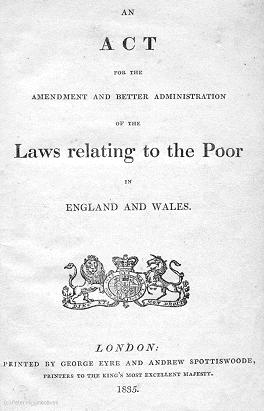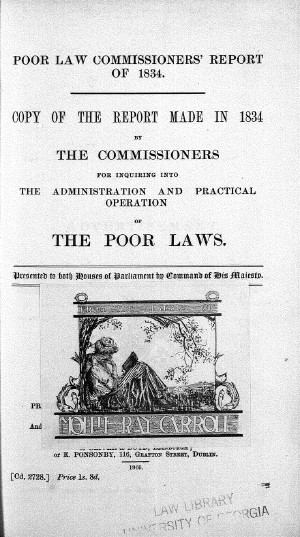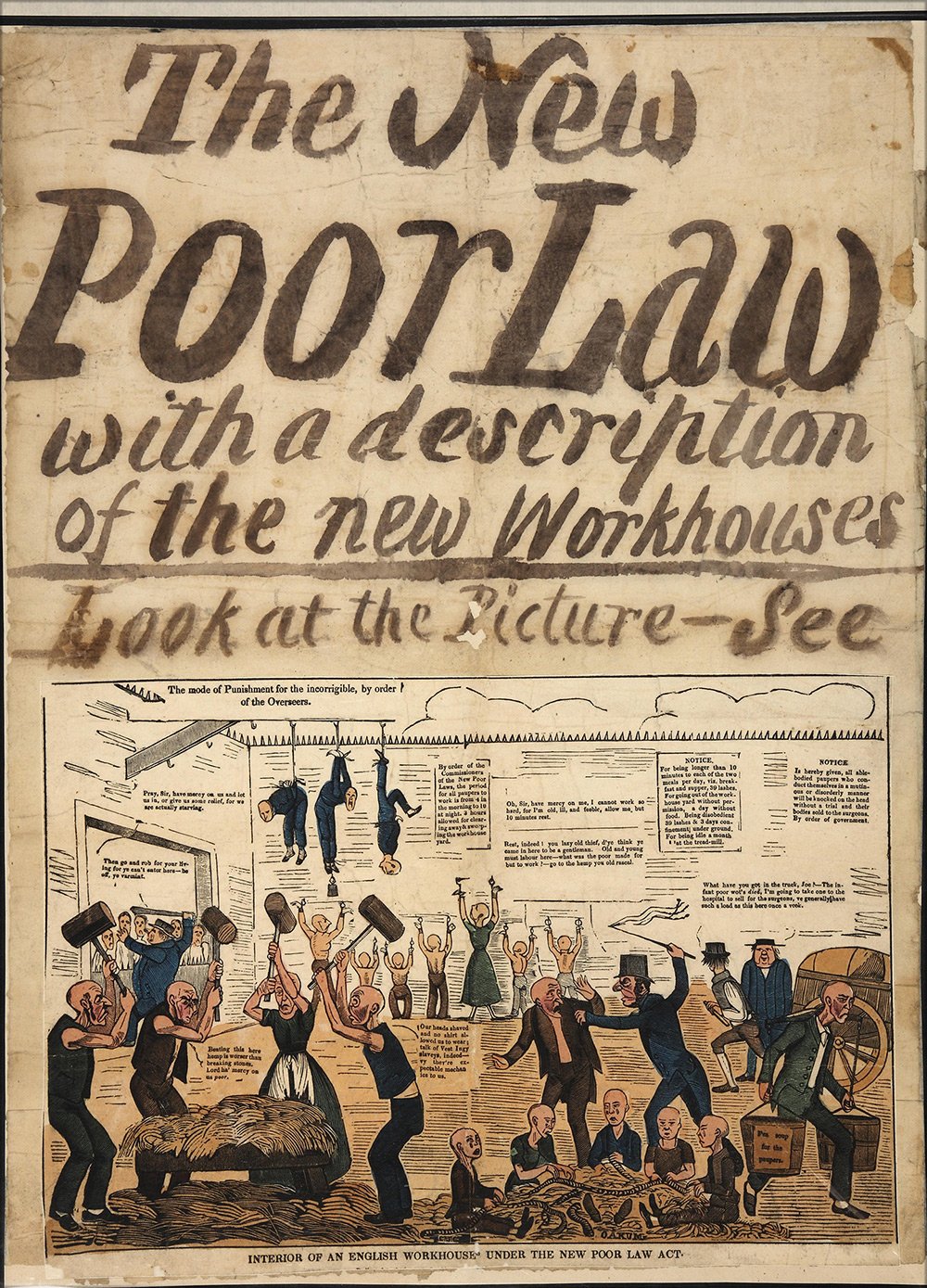The Poor Law Amendment Act of 1834 changed welfare in England. It aimed to reduce the cost of supporting the poor.
This act transformed how society viewed poverty and assistance. Before 1834, support was given directly to the needy in their own homes. The new law introduced workhouses, where conditions were harsh to deter people from seeking aid. It shifted the focus from helping the poor to encouraging self-reliance.
Many debated whether this act was fair or cruel. It sparked widespread discussions on poverty and responsibility. Understanding the Poor Law Amendment Act helps us see how past policies shaped current welfare systems. It offers insight into historical attitudes towards poverty and the measures taken to address it.
Origins Of The Poor Law
The Poor Law Amendment Act of 1834 marked a significant change in British welfare. To understand this, we must explore the origins of the Poor Law. This journey takes us back to medieval times and the Elizabethan era. These periods laid the groundwork for later reforms. They shaped ideas about poverty and social responsibility. Let’s delve into these historical roots.
Medieval Roots
In medieval England, the community cared for the poor. Churches played a key role in this support system. They collected alms and distributed them to those in need. This system was informal and varied from place to place. Lords and wealthy landowners also helped the poor. They provided food and shelter during harsh times. This support was seen as a moral duty.
As the population grew, poverty increased. The traditional support system struggled to cope. This led to the need for a more structured approach. The seeds for future laws were sown during this era. These medieval roots influenced later developments in poor relief.
Elizabethan Foundations
The Elizabethan era brought significant changes to poor relief. In 1601, the Elizabethan Poor Law was enacted. This law formalized the care of the poor. It required local parishes to support their impoverished residents. Taxes funded this support, collected from property owners.
The law divided the poor into categories. The “deserving” poor received aid, while the “undeserving” did not. This categorization aimed to discourage idleness. The Elizabethan Poor Law was a significant step. It created a framework that lasted for centuries. This law influenced the Poor Law Amendment Act of 1834.

Credit: www.workhouses.org.uk
The Crisis Of The Old System
The Poor Law Amendment Act of 1834 aimed to reform welfare by reducing costs and encouraging work. It introduced workhouses where the poor were required to live and work to receive aid. This act faced criticism for its harsh conditions and impact on vulnerable communities, highlighting the flaws in the existing system.
The Poor Law Amendment Act of 1834 marked a pivotal change in how Britain addressed poverty. But why was a change needed? The old system was crumbling under its own weight, and the consequences were dire. People were suffering, and the economy was straining. Let’s explore the crisis that demanded reform, focusing on two critical aspects: rising costs and social unrest.
Rising Costs
The old Poor Law system was becoming unsustainable. The costs of supporting the poor were skyrocketing, draining local resources. Parishes, the local administrative units responsible for welfare, were struggling to keep up with the financial burden.
Imagine being a parish treasurer in the 1830s. You’d face mounting pressure as more people needed help, with funds dwindling. It wasn’t just about numbers; it was about real lives hanging in the balance.
The situation forced communities to choose between raising taxes or cutting assistance. Both options were unpopular, leading to increased tension and dissatisfaction. Does this sound familiar? Budget constraints still challenge modern welfare systems, showing how history often repeats itself.
Social Unrest
Beyond the financial strain, the old system fueled social unrest. People were frustrated with the inequities and inefficiencies of the existing structure. Many felt trapped in poverty with no real hope of escape.
The discontent was palpable. Protests and riots erupted as people demanded better support and fair treatment. It wasn’t just the poor voicing their grievances; middle-class citizens were also concerned about safety and stability in their communities.
You can see parallels with today’s society, where economic disparities often lead to unrest. It begs the question: How should governments balance fiscal responsibility with social justice?
When you look back at the crisis of the old system, it’s clear why reform was inevitable. The Poor Law Amendment Act of 1834 wasn’t just a legislative change; it was a necessary response to a broken system. Understanding these historical challenges can offer valuable insights into contemporary debates on welfare and social policy.
Key Provisions Of The 1834 Act
The Poor Law Amendment Act of 1834 was a major shift in welfare. It aimed to make assistance more efficient and less costly. This Act introduced key provisions that changed the way poor relief was administered in England.
Workhouse System
The Act established a new system of workhouses. These were places where the poor could receive help. Conditions in workhouses were deliberately harsh. This was to discourage people from seeking help. The idea was to motivate the poor to find work outside. Families were often separated in workhouses. This was one more reason to avoid them.
Centralized Administration
The Act created a centralized administration for relief. Local parishes lost control over poor relief. A central Poor Law Commission was set up. This body oversaw all workhouses and relief efforts. It ensured uniformity in how relief was provided. This helped reduce costs and improve efficiency. Local governments followed strict guidelines from the Commission.
Impact On Poverty And Society
The Poor Law Amendment Act of 1834 was a significant shift in British social policy. It aimed to reduce the cost of caring for the poor by reforming the existing system. This law had profound effects on poverty and society, changing the landscape of public support and welfare.
Shift In Public Attitudes
Before the Act, people believed in helping the poor through local parish relief. The new law changed this view, promoting self-reliance and discouraging dependency. Society started to see poverty as a result of personal failings. This shift led to a harsher treatment of the poor and reduced empathy.
Public opinion saw the poor as lazy or unwilling to work. Many thought the workhouses were necessary to encourage effort and responsibility. These attitudes reinforced a divide between the poor and the rest of society. The Act’s strict measures were seen as a tool to motivate the poor to improve their situation.
Effects On The Poor
The Poor Law Amendment Act forced many into workhouses. Life inside was hard and dehumanizing. Families were split, and individuals were subjected to strict routines. The workhouses aimed to make relief unattractive, discouraging reliance on public aid.
The poor faced stigma and isolation due to the Act. It deepened societal divisions and increased the struggles of those in poverty. Many felt trapped and without hope, as the system offered little chance for improvement. The Act failed to address the root causes of poverty, focusing more on deterrence than assistance.
Controversies And Criticisms
The Poor Law Amendment Act of 1834 stirred much debate. Critics voiced concerns about its impact on society and welfare. Many believed it lacked compassion for the poor.
Opposition From Reformers
Reformers argued the Act was harsh and unfair. They claimed it punished the poor for their misfortune. The workhouses were a major point of contention. Reformers described them as prisons for the destitute. Conditions were intentionally bleak to deter reliance on aid. Critics saw this as a moral failing of society.
Prominent figures like Charles Dickens condemned the system. Through his writings, Dickens highlighted the inhumanity of the Act. Reformers pushed for changes that offered dignity and support.
Debate On Humanitarianism
The Act sparked debates on humanitarian values. Critics questioned whether it showed true compassion. They argued that it ignored the root causes of poverty. The focus was on reducing government spending, not helping people. This approach seemed to prioritize economy over empathy. Many felt it was a step backward for society.
Philosophers and social thinkers joined the debate. They urged for reforms that considered the human element. The Act highlighted tensions between economic efficiency and social care. This debate continued to shape welfare policies for years.
Role Of Workhouses
In 1834, the Poor Law Amendment Act transformed the system of social welfare in England. Central to this reform were workhouses, designed to provide relief to the destitute. These institutions aimed to deter dependency on public funds and encourage self-reliance. Workhouses offered basic shelter and food but demanded labor in return. They became a symbol of the era’s harsh approach to poverty. Understanding their role reveals much about the society’s attitudes towards the poor.
Living Conditions
Workhouses were often overcrowded and unsanitary. Families were separated, with men, women, and children housed in different sections. The buildings were cold and poorly maintained. Minimal food was provided to sustain the inmates. Meals usually consisted of bread, porridge, and potatoes. The lack of privacy and comfort made life difficult. Many viewed workhouses as places of last resort.
Labor And Discipline
Residents were required to work long hours. Tasks included breaking stones, picking oakum, and weaving. Labor was meant to instill discipline and deter laziness. Strict rules governed daily life. Inmates faced punishment for minor infractions. The work was often tedious and physically demanding. Discipline was maintained through a rigid schedule and harsh oversight. The regime was intended to encourage the poor to seek employment outside.
Long-term Effects
The Poor Law Amendment Act of 1834 was a pivotal moment in British history, reshaping the landscape of social welfare. Over time, its effects have transcended its original scope, influencing modern welfare systems worldwide. But how exactly did this piece of legislation leave a mark on the present-day social policies?
Influence On Modern Welfare
The Poor Law Amendment Act laid the foundation for the welfare systems we see today. By creating a centralized system of poor relief, it introduced the concept of government responsibility in supporting the needy. This shift set the stage for future policies that prioritize state intervention in social welfare.
Many elements of this act have echoes in current welfare programs. The idea of workhouses, albeit controversial, was an early attempt to provide structured support, similar to some modern job training schemes. Today, nations strive for a balance between assistance and self-sufficiency, a challenge first addressed by this historic law.
Reflecting on this, think about the impact of centralized welfare in your community. How has government support shaped your environment, and what improvements can still be made?
Legacy In Public Policy
The legacy of the Poor Law Amendment Act is visible in public policy across the globe. Its influence is evident in the way governments approach poverty and unemployment, emphasizing organized support systems. These policies have evolved, aiming to protect citizens while encouraging economic stability.
Public debates today often circle back to principles embedded in the 1834 Act. Discussions about the extent of government involvement in welfare, and the balance between aid and empowerment, echo the debates of the past. This historic legislation continues to be a reference point for policymakers.
Consider how public policy in your area has evolved. Are there elements of the Poor Law’s legacy that still resonate, and how might they be improved to better serve today’s needs?

Credit: oll.libertyfund.org
Reforms And Repeal
The Poor Law Amendment Act of 1834 reshaped welfare in Britain. It aimed to reduce costs and discourage idleness by creating workhouses. These reforms sparked debate and controversy, leading to eventual repeal due to harsh conditions.
The Poor Law Amendment Act of 1834 marked a significant shift in how Britain addressed poverty and social welfare. Initially designed to reduce the cost of poverty relief and deter dependency, it introduced workhouses where the poor were housed and required to work. However, public discontent grew over time, leading to calls for reform and eventual repeal. This section delves into how these reforms reshaped social policy and led to the decline of the workhouse system.
Toward More Humane Policies
In the mid-19th century, pressure mounted for reforms that recognized the dignity and rights of the poor. Public opinion shifted, and people began to see the harsh conditions of workhouses as inhumane. The government responded by implementing changes to improve living conditions and provide better support.
Reforms included the introduction of outdoor relief, allowing the poor to receive aid without entering workhouses. This change acknowledged that not all individuals could work due to age or illness. It was a step toward recognizing the diverse needs of the impoverished population.
What changes do you think could have been implemented to make these policies even more effective? Reflecting on such questions can help us understand the importance of empathy in policy-making. The reforms paved the way for later welfare systems that prioritized human dignity over economic efficiency.
End Of The Workhouse Era
The repeal of the workhouse system was not an overnight event; it was a gradual process influenced by growing awareness and advocacy. By the early 20th century, workhouses had become symbols of outdated and ineffective policies. Public sentiment and political will aligned to bring about their end.
The Local Government Act of 1929 marked the beginning of the end. It transferred the responsibilities of poor relief from individual workhouses to local government councils. This shift emphasized community responsibility and localized solutions.
Imagine living in a time where your community’s well-being was a shared responsibility. This approach laid the groundwork for modern social services. It highlighted the need for tailored solutions rather than one-size-fits-all approaches.
The workhouse era serves as a reminder of the evolving nature of social policies. It encourages us to consider how current policies might be perceived in the future and the ongoing need for reform. What might today’s policies look like in the eyes of future generations?
FAQs
What Was The Poor Law Amendment Act Of 1834?
The Poor Law Amendment Act of 1834 aimed to reform the poverty relief system in England. It established workhouses for the poor, discouraging reliance on government aid. The Act intended to reduce costs and encourage self-reliance among the poor. Critics argued it was harsh and inhumane.
What Are The 5 Important Factors Of The Elizabethan Poor Laws?
The Elizabethan Poor Laws focused on local responsibility, taxation for funding, categorizing the poor, workhouses, and outdoor relief.
How Did The 1834 Poor Law Impact The Industrial Revolution?
The 1834 Poor Law increased labor supply by forcing the poor into workhouses. This lowered wages and fueled industrial growth. It intensified urbanization as people moved to cities for jobs, accelerating the Industrial Revolution. The law also highlighted class disparities, influencing future social reforms.
What Was The Poor Law Of 1834 Oliver Twist?
The Poor Law of 1834 aimed to reduce poverty costs by creating workhouses. Oliver Twist, a novel by Charles Dickens, depicts the harsh conditions and treatment in these institutions, highlighting the law’s impact on the poor and vulnerable. Dickens criticized the law for its inhumane approach.
Conclusion
The Poor Law Amendment Act of 1834 changed many lives in England. It aimed to make the welfare system more efficient. Many people found workhouses harsh and unfair. Critics argued it lacked compassion. The act influenced future policies on poverty and welfare.
Understanding its impact helps us learn from history. It highlights the need for balance in social reforms. Society must care for vulnerable people while promoting self-reliance. The act reminds us of the ongoing struggle against poverty. Lessons from the past guide us to create better systems today.








